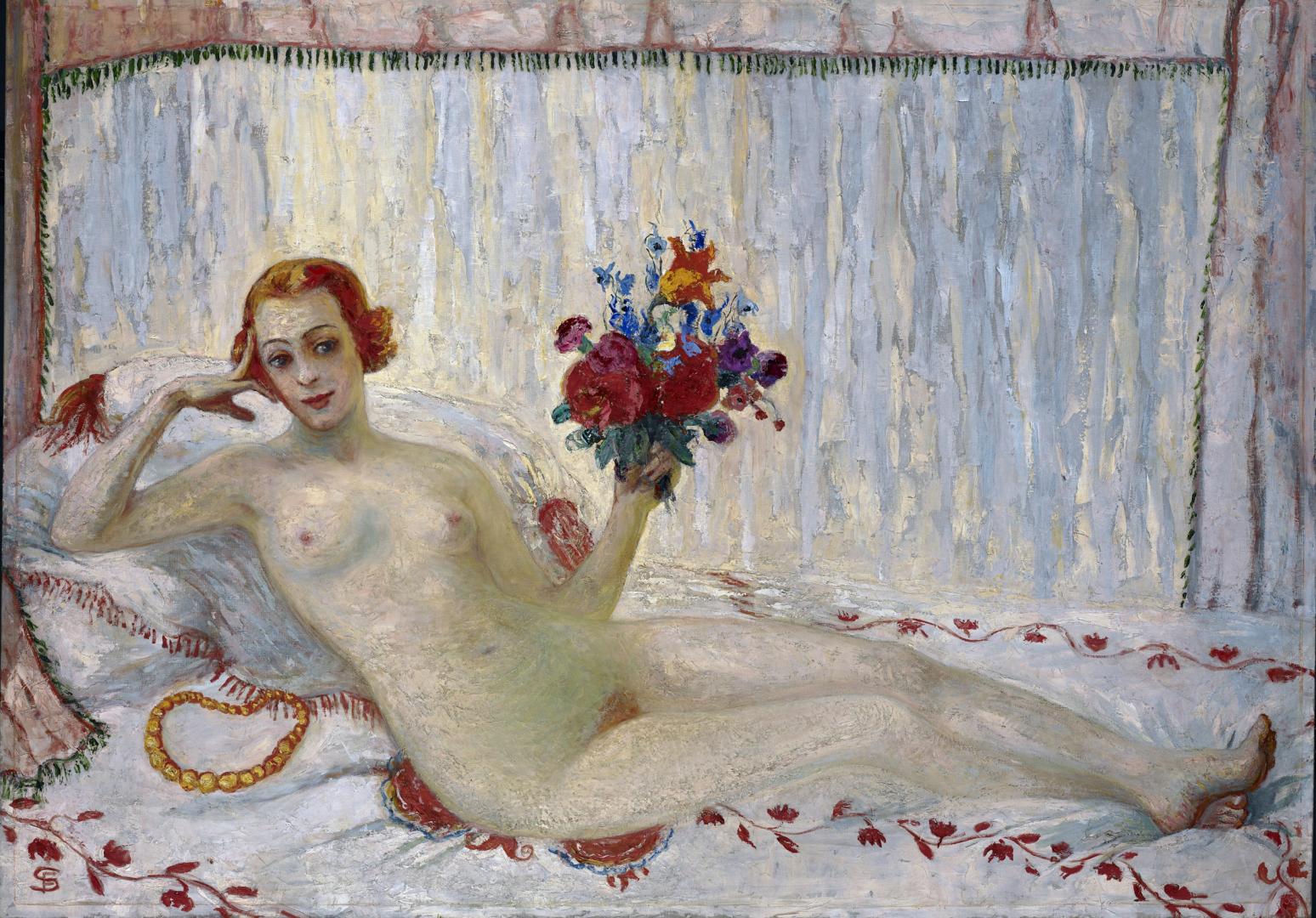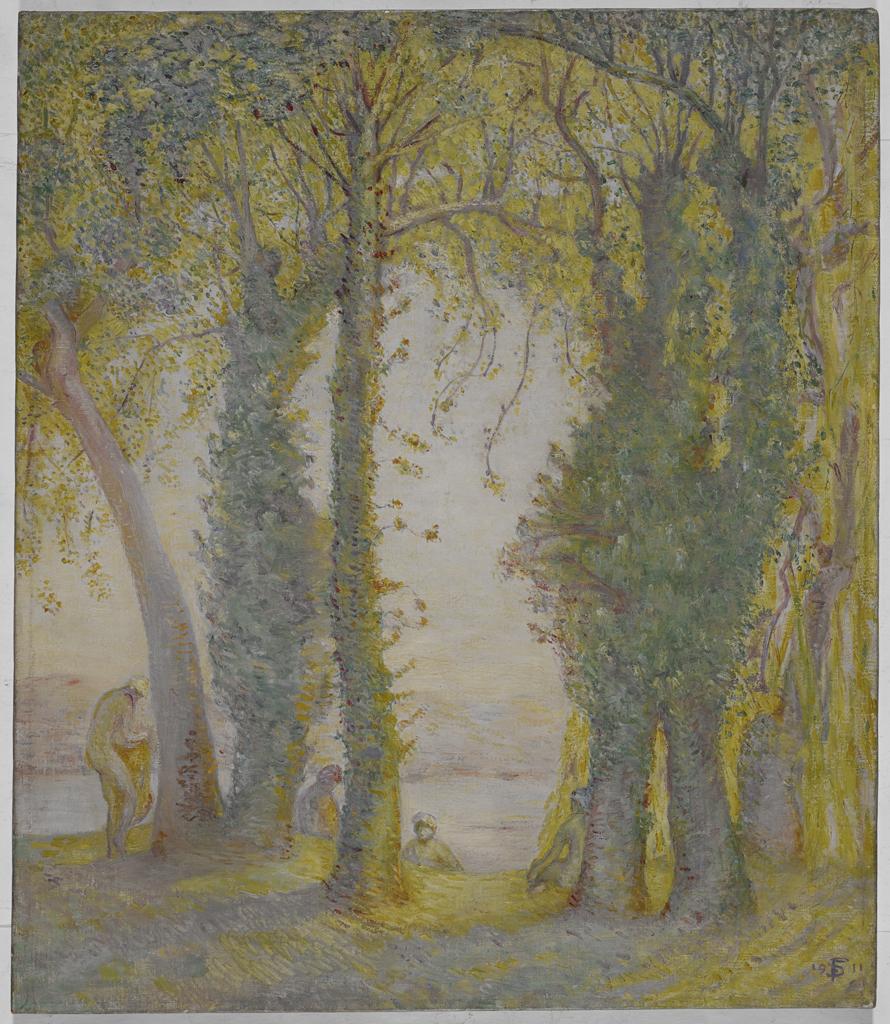By Katie Pratt-Thompson and Clara Zevi
Dr. Barbara Bloemink is the author of what is now the foundational text on the artist Florine Stettheimer. This
book, The Life and Art of Florine Stettheimer (Yale University Press, 1995) introduced a new way
of looking at the artist's oeuvre. Bloemink replaced the dominant image of the American artist as a wealthy,
Jewish, New York socialite, with a more complex narrative. Through a thorough biography and close attention to
Stettheimer's style and the content of her paintings, Bloemink's book presents an artist making
expressive and dynamic modern art, charged with social commentary.
Bloemink received her Ph.D. from Yale and holds master's degrees from Yale and NYU's Institute of
Fine Arts. Since then she has written and lectured extensively, teaching graduate art history at the University of
Brighton and the University of Kansas. Bloemink was the Curatorial Director of the Cooper-Hewitt Smithsonian Design
Museum, New York and the Director and Chief Curator of the Kemper Museum of Art and Design, Kansas City,
Missouri; the Guggenheim-Hermitage and Guggenheim Las Vegas Museums; and the Hudson River Museum.
Earlier plans to meet with Dr. Bloemink in person were postponed due to the COVID-19 pandemic, and so this interview with her took place on Zoom on October 23, 2020. Bloemink calls in from her home in New York. Hanging high up on the wall behind her, is a painted portrait showing her blonde mane. She greets us and begins, with visible joy, by sharing the news that a Florine Stettheimer painting she has never been able to track down has finally appeared on the market.
Clara Zevi:
We could not have asked for a better person to speak with about Stettheimer's practice and its reception, as
we develop our exhibition project. We are so delighted that you are here to share your insights into this
fascinating artist with us.
Barbara Bloemink:
When I wrote my doctoral dissertation, my mentor asked, “Why are you writing on Stettheimer? She's a
terrible artist!” That was at Yale and they had five of her best paintings and all of her correspondence.
My book was basically just finding all of her works, like all the works in the Columbia basement, and dating
them. But I didn't put her in context. I got some things wrong, I was only 30 and now I'm 60.
Stettheimer didn't start her new style until she was 45, and she worked until she was 70.
Katie Pratt-Thompson:
You have worked extensively on Stettheimer since publishing your 1995 monograph. How else has your perception
shifted over the years?
BB:
I read everything. I looked at every book she ever read, I looked at every theatrical production she and her
sisters went to in their 20s and 30s. Now that I am older, I realize context is important. I looked up and know
every building in every painting, who all the people that can be identified are, and every object that can be
identified.
The reason I went back to her after being a contemporary art curator for 20 years, is that I had to correct art
history about her.
CZ: Was Stettheimer what you would describe as a feminist? Was she a feminist artist?
BB:
She was an absolute feminist. Look at her paintings from 1915. She's wearing white pantaloons [Self-Portrait
with Palette, c. 1915. Art Properties, Avery Architectural and Fine Arts Library, Columbia University in
the City of New York]. Women didn't wear pants then unless they were feminists or lesbians. She got
clothing from Paris, but she wore spangled pants, which she had her seamstress make. She later had black velvet
pants made, which she shows herself wearing in her paintings in her 70s. She also always painted herself with
red high heels. At 46, she paints herself as the prostitute in
[Manet's] Olympia [1863, Musée d'Orsay, Paris, France] in A
Model (Nude Self-Portrait) [c. 1915. Art Properties, Avery Architectural and Fine Arts
Library, Columbia University in the City of New York] and she paints herself with this great
body.

She goes with her sister to the women's voting congresses. She paints the first paintings of women on
their own, lying nude like Venus on the half shell, in a women-only swimming pool [Natatorium Undine, 1927.
Frances Lehman Loeb Art Center, Vassar College, Poughkeepsie, NY]. She paints women fighting over a sale at a
women's department store. She paints women in their own context. If you look at her diaries, every book
she reads, other than Proust and scientific and art books, is a strong woman's biography. She goes to
erotic productions of Salome and to Nijinsky's Afternoon of a Faun. She went to
[Henrik] Ibson's A Doll's House, wherein the play the wife walks out on her husband
because she doesn't have freedom.
She went to see all plays that were in the least bit feminist. One of her remarks about a play she saw is: “Men would like this, but no feminist could ever enjoy it.” This woman is a feminist from the time she is 20. She goes to the Arts Student League in New York, because other than the Pennsylvania Academy, it was the only art school in America where women could learn to paint and draw from male nudes, and not plasters.
CZ:
You brought up the 1915 Nude Self-Portrait, Stettheimer's take on
Manet's Olympia, which is in Columbia's collection. Our exhibition focuses on
Stettheimer's training and early career and includes several academic nude studies made during her
time at the Art Students League in the 1890s. Do you see a development in how Stettheimer looks at the female body,
from the early nudes onwards?
BB:
Very much. The first thing that struck me, and continues to be very clear to me about the early nudes, is that
she had studied German academic painting so thoroughly, with private tutors in Europe from age 12. She
understood the Munich school of academic training, so when she came to the Art Students League, she studied with
[James Carroll] Beckwick and artists that could give her French academic training, and who had gone to the École
des Beaux-Arts. She proved in those early nudes, both the drawings and paintings at Columbia, that she could
paint as well as any male academic painter, except the greatest masters. She understood chiaroscuro,
perspective, and she painted every dimple on the body. She didn't idealize.
So at 46, [when she painted A Model (Nude Self-Portrait)] she was considered late middle-aged or
early-old. The idea that she is painting herself naked is ridiculous! Look at the parts that she emphasizes the
most: her feet, her face and her pubic hair. It's based on the Titian [Venus of Urbino, 1534. The
Uffizi, Florence, Italy], the Goya [Maja Desnuda, 1795-1800. Museo del Prado, Madrid, Spain], the Manet
[Olympia, 1863].
The traditional nude is for male voyeurism. It was never painted for anything but men, usually to hide in their
bedrooms and for them to masturbate to.
This is the second nude self-portrait by a woman, full body, that anyone I know has been able to ever find in
western art history. And it's the first feminist one, from a female view. So that is where she takes the
academic nudes 20 years later, when she is a full feminist.
KPT:
Columbia holds the largest collection of the artist's works, which were gifted to the University by her sister
Ettie. We noticed in Stettheimer's early sketchbooks that there are many depictions of trees and nature.
What do you make of the attention to nature in her early work and do you think there is any connection between these
verdant landscapes and her floral birthday bouquets?
BB:
Not really to the latter. The flowers are extremely singular to her.
Look at her poetry, the flowers were something she called “eye-gays,” they were a birthday present
to herself. And she tried to paint a flower painting every birthday. She made many, many bouquets throughout her
life. Flowers were very special to her, but she was absolutely not a symbolist. Flowers were what they were.
They were beautiful. They were for the eye.
She's working through every style, especially important are the Pointillist paintings
[see Landscape No. 2 with Bathers, 1911].
Matisse did an almost identical pointillist painting with the trees and the bathers [Luxe, Calme et
Volupté, 1904. Musée d'Orsay, Paris France]
She saw Dada art, she saw Cubism, she saw Pointillism, she saw Fauvism in Europe. She went to all the early
salons. She went to all of the galleries. She saw Matisses. She saw Cézannes. And she was constantly frustrated
when she couldn't work.
She's also working through every medium, trying watercolor, gouache, pencil, oil painting, encaustic,
murals, plaster, everything. She is teaching herself every style of painting, every medium, everything she can
do. And the one she falls in love with the most, is Matisse. [But] from 1916-1918 on, she never makes a
leaf again. Never.

KPT:
It is wonderful to think about these landscapes in terms of her learning process and how she developed [as an
artist].
CZ:
We wanted to ask you if you see elements, whether technical or stylistic, in Stettheimer's early work
that manifest in her later paintings?
BB:
Absolutely, but in her theatrical work, in her early ballet that's at MoMA. If that had been produced, she
would have immediately been known as one of the great, innovative, theatrical designers. Everything about her
mature work is based on theater.
CZ:
Let's go back to the Arts Student League studies. Can you talk about how she was looking at the body in these
very early years?
BB:
What I love about these is that they're absolutely honest. She's painting a real woman's body [Nude
Study, Standing with Hand to Shoulder]. And the women, they're plain. They're not beautiful. She
painted [the models] as inordinately bored, which I love. So these are studies, they're not completed
paintings, but they're beautifully painted with shadow and complexity. She is a master academic
painter.
KPT:
Could you speak more to her honesty and self-assuredness? How do you see these developing over time?
BB:
[Carl] Van Vechten says, “Florine was a completely self-centered and dedicated person. She did not inspire
love or affection or even friendship, but she did inspire interest, respect, admiration, and
enthusiasm.”
She went to all the major feminist theater. [She] held salons…[where] she had the top feminists of her time, writers, amazing women, at tea.
CZ:
Lastly, what is one thing that people should know about Florine Stettheimer?
BB:
That she exhibited forty-six times, in the top exhibitions, including the first Whitney Biennial, all the early
MoMA shows, the Jeu de Paume in Paris, the Carnegie International, and a number of retail galleries, including
Knoedler. She and [Georgia] O'Keeffe were the only woman artists that the Museum of Modern Art curators
[Kathy Curry and Esther Adler] included in the first exhibition of American paintings [American Modern:
Hopper to O'Keeffe].
And that she was a completely self-confident, professional artist.
